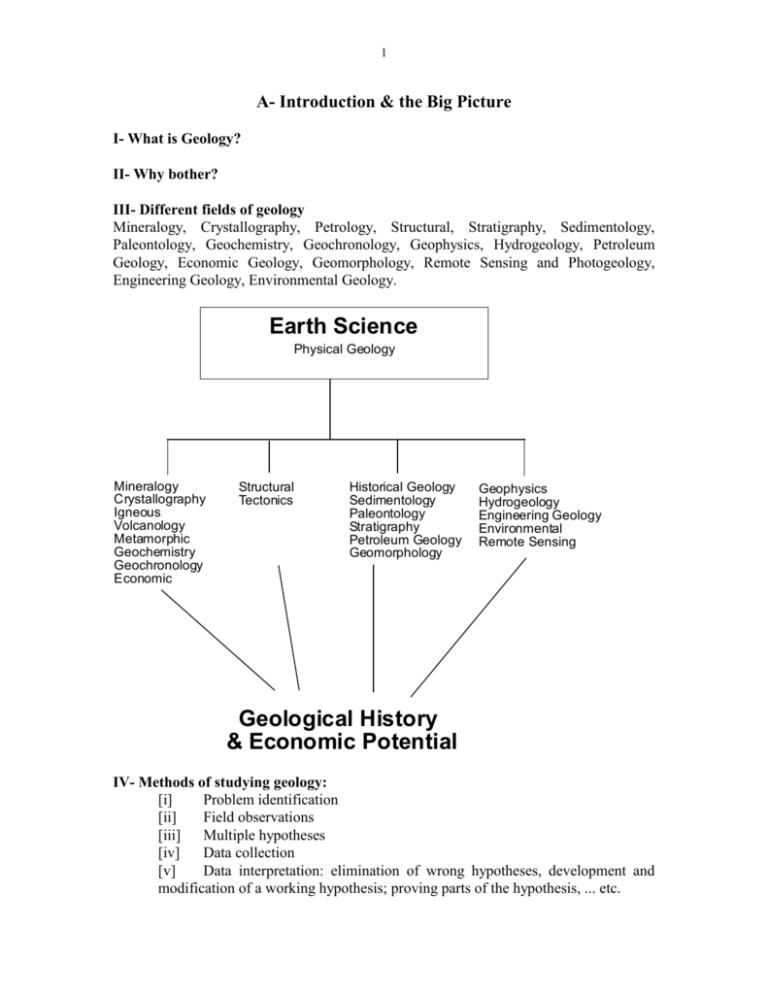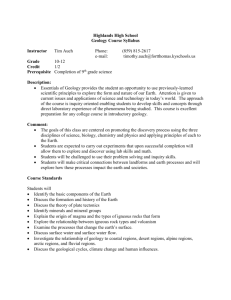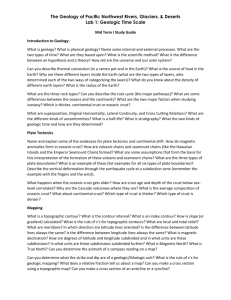Introduction & the big picture
advertisement

1 A- Introduction & the Big Picture I- What is Geology? II- Why bother? III- Different fields of geology Mineralogy, Crystallography, Petrology, Structural, Stratigraphy, Sedimentology, Paleontology, Geochemistry, Geochronology, Geophysics, Hydrogeology, Petroleum Geology, Economic Geology, Geomorphology, Remote Sensing and Photogeology, Engineering Geology, Environmental Geology. Earth Science Physical Geology Mineralogy Crystallography Igneous Volcanology Metamorphic Geochemistry Geochronology Economic Structural Tectonics Historical Geology Sedimentology Paleontology Stratigraphy Petroleum Geology Geomorphology Geophysics Hydrogeology Engineering Geology Environmental Remote Sensing Geological History & Economic Potential IV- Methods of studying geology: [i] Problem identification [ii] Field observations [iii] Multiple hypotheses [iv] Data collection [v] Data interpretation: elimination of wrong hypotheses, development and modification of a working hypothesis; proving parts of the hypothesis, ... etc. 2 V- Scientific method in general: Hypothesis, Theory, Law! Differences between Geology and other Physical Sciences Difficulty of dealing with geologic time! VI- Geologic time: (a) Early concepts & controversies: Uniformitarianism vs. Catastrophism James Hutton’s Uniformitarianism: "Present is the key to the past" (b) Relative and absolute time: Absolute age dating: making use of radioactive isotopes of known decay rates. Relative age dating (Fig. 1): based on: (i) Principle of original horizontality (ii) Principle of superposition of strata (iii) Principle of lateral continuity (iv) Principle of cross cutting relations (v) Principle of inclusions (c) Geologic Time scale (Fig. 2): Combining relative and absolute age dating. Oldest rocks on Earth: 3.96 byrs. Age of the Earth: ~ 4.7 byrs. VII- Facts and figures about the Earth: Shape & Size Equatorial Radius: Polar Radius Equatorial Circumference Polar Circumference km 6378.4 6356.9 40077 40009 Elevations/ depths Highest Mountain: Mount Everest: 8.84 km (29,028 ft) Average elevation: ~ 840 m (2757 ft) Deepest Ocean/ sea: Marianas Trench: 11.03 km (36,204 ft) Average depth: 3.8 km (12,460 ft). Areas Land: 29.22 % (149 . 106 km2) Oceans + seas: 70.78% (361 . 106 km2) Densities: Miles 3963.4 3950 24902 24857 3 Earth (average): 5.5 g/cm3 Crust: Continental 2.7 g/cm3; Oceanic: 3 g/cm3 Mantle: 3.3 – 5.7 g/cm3 Core: ~ 11 or 12 g/cm3 Rock types and the Rock Cycle: (Fig. 3) B- Composition and Layered Structure of the Earth "Lithosphere", Hydrosphere, Atmosphere, and Biosphere Methods of finding out the earth's internal structure: [i] Seismic velocities [ii] Density [iii] Continental and Ocean Drilling [iv] Mountain belts [v] Ophiolites [vi] Meteorites [vii] Volcanoes & xenoliths The Earth's internal structure (according to composition) (Figs. 4 & 5): (i) Inner core which is rich in Fe and believed to be in the solid state. This core has a radius of about 1216 km. (ii) Outer core rich in molten Fe and Ni. This layer is 2255 km thick. Gutenberg discontinuity (iii) Mantle made up of Fe and Mg silicates reaching a thickness of 2885 km. The rocks in the mantle have a density of about 3.3 g/cm3 (Table 1) Mohorovicic discontinuity (iv) Crust: 6 to 60 km in thickness, made of silicates that are less dense then those in the mantle. The crust is of two kinds: (Table 2) (a) Continental crust made mostly of sedimentary and acidic or felsic igneous rocks, with an average thickness of 35 km but reaching 60 km in high mountain ranges. The density of the continental crust is ~ 2.7 gm/c.c. The two most common elements that constitute the continental crust are Si and Al, and it is therefore called sial. (b) Oceanic crust made mostly of basic and ultrabasic (mafic and ultramafic) igneous rocks, with a thickness of 6 to 10 km. This crust occurs on the ocean floor and has an average density of about 3.0 gm/cc. It is rich in Mg and Si, and was therefore named sima. Major, Minor and Trace elements (Table 2) Eight elements considered “major”, as they constitute 99% by weight of the Earth. These elements, listed in order of their abundance within the continental crust are: O, Si, Al, Fe, Mg, Ca, Na, and K. 4 Minor elements are those whose oxides constitute between 0.1 and 1% by weight of the average crust. These include: Ti, P, Mn, and C. Average Composition of the Earth (Table 3). Unlike the crust in which O is the most abundant element, Fe is the most abundant element in the Earth overall. This is simply because the Earth has a sizeable Fe-rich core. In fact, 4 elements constitute 95% of the bulk earth.







